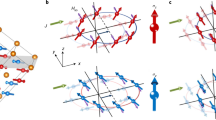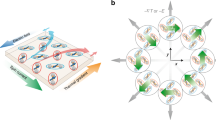Abstract
Controlling spin-related material properties by electronic means is a key step towards future spintronic technologies. The spin Hall effect (SHE) has become increasingly important for generating, detecting and using spin currents, but its strength—quantified in terms of the SHE angle—is ultimately fixed by the magnitude of the spin–orbit coupling (SOC) present for any given material system. However, if the electrons generating the SHE can be controlled by populating different areas (valleys) of the electronic structure with different SOC characteristic the SHE angle can be tuned directly within a single sample. Here we report the manipulation of the SHE in bulk GaAs at room temperature by means of an electrical intervalley transition induced in the conduction band. The spin Hall angle was determined by measuring an electromotive force driven by photoexcited spin-polarized electrons drifting through GaAs Hall bars. By controlling electron populations in different (Γ and L) valleys, we manipulated the angle from 0.0005 to 0.02. This change by a factor of 40 is unprecedented in GaAs and the highest value achieved is comparable to that of the heavy metal Pt.
This is a preview of subscription content, access via your institution
Access options
Subscribe to this journal
Receive 12 print issues and online access
$259.00 per year
only $21.58 per issue
Buy this article
- Purchase on Springer Link
- Instant access to full article PDF
Prices may be subject to local taxes which are calculated during checkout





Similar content being viewed by others
References
Kato, Y. K., Myers, R. C., Gossard, A. C. & Awschalom, D. D. Observation of the spin Hall effect in semiconductors. Science 306, 1910–1913 (2004).
Wunderlich, J., Kaestner, B., Sinova, J. & Jungwirth, T. Experimental observation of the spin-Hall effect in a two dimensional spin–orbit coupled semiconductor system. Phys. Rev. Lett. 94, 047204 (2005).
Dyakonov, M. I. & Perel, V. I. Current-induced spin orientation of electrons in semiconductors. Phys. Lett. A 35, 459–460 (1971).
Dyakonov, M. I. & Perel, V. I. Possibility of orienting electron spins with current. JETP Lett. 13, 467–470 (1971).
Hirsch, J. E. Spin Hall effect. Phys. Rev. Lett. 83, 1834–1837 (1999).
Sinova, J. et al. Universal intrinsic spin-Hall effect. Phys. Rev. Lett. 92, 126603 (2004).
Murakami, S., Nagaosa, N. & Zhang, S-C. Dissipationless quantum spin current at room temperature. Science 301, 1348–1351 (2003).
Jungwirth, T., Wunderlich, J. & Olejnik, K. Spin Hall effect devices. Nature Mater. 11, 382–390 (2012).
Valenzuela, S. O. & Tinkham, M. Direct electronic measurement of the spin Hall effect. Nature 442, 176–179 (2006).
Saitoh, E., Ueda, M., Miyajima, H. & Tatara, G. Conversion of spin current into charge current at room temperature: Inverse spin-Hall effect. Appl. Phys. Lett. 88, 182509 (2006).
Kimura, T., Otani, Y., Sato, T., Takahashi, S. & Maekawa, S. Room-temperature reversible spin Hall effect. Phys. Rev. Lett. 98, 156601 (2007).
Ando, K. et al. Electrically tunable spin injector free from the impedance mismatch problem. Nature Mater. 10, 655–659 (2011).
Matsuzaka, S., Ohno, Y. & Ohno, H. Electron density dependence of the spin Hall effect in GaAs probed by scanning Kerr rotation microscopy. Phys. Rev. B 80, 241305 (2009).
Garlid, E. S., Hu, Q. O., Chan, M. K., Palmstrom, C. J. & Crowell, P. A. Electrical measurement of the direct spin Hall effect in Fe/InxGa1−xAs heterostructures. Phys. Rev. Lett. 105, 156602 (2010).
Liu, L., Buhrman, R. A. & Ralph, D. C. Review and analysis of measurements of the spin Hall effect in platinum. Preprint at http://arXiv.org/abs/1111.3702 (2011)
Mosendz, O. et al. Detection and quantification of inverse spin Hall effect from spin pumping in permalloy/normal metal bilayers. Phys. Rev. B 82, 214403 (2010).
Liu, L. et al. Spin-torque switching with the giant spin Hall effect of tantalum. Science 336, 555–558 (2012).
Niimi, Y. et al. Extrinsic spin Hall effect induced by iridium impurities in copper. Phys. Rev. Lett. 106, 126601 (2011).
Niimi, Y. et al. Giant spin Hall effect induced by skew scattering from bismuth impurities inside thin film CuBi alloys. Phys. Rev. Lett. 109, 156602 (2012).
Pai, C-F. et al. Spin transfer torque devices utilizing the giant spin Hall effect of tungsten. Appl. Phys. Lett. 101, 122404 (2012).
Gunn, J. B. Microwave oscillations of current in III–V semiconductors. Solid State Commun. 1, 88–91 (1963).
Butcher, P. N. The Gunn effect. Rep. Prog. Phys. 30, 97–148 (1967).
Meier, F. & Zakharchenya, B. P. Optical Orientation (North-Holland, 1984).
Miah, M. I. Observation of the anomalous Hall effect in GaAs. J. Phys. D 40, 1659–1663 (2007).
Wunderlich, J. et al. Spin-injection Hall effect in a planar photovoltaic cell. Nature Phys. 5, 675–681 (2009).
Wunderlich, J. et al. Spin Hall effect transistor. Science 330, 1801–1804 (2010).
Okamoto, N. et al. Spin current depolarization under high electric fields in undoped InGaAs. Appl. Phys. Lett. 98, 242104 (2011).
Lei, X. L., Xing, D. Y., Liu, M., Ting, C. S. & Birman, J. L. Nonlinear electronic transport in semiconductor systems with two types of carriers: Application to GaAs. Phys. Rev. B 36, 9136–9141 (1987).
McCumber, D. E. & Chynoweth, A. G. Theory of negative-conductance amplification and of Gunn instabilities in ‘two-valley’ semiconductors. IEEE Trans. Electron Devices 13, 4–21 (1966).
Moss, T. S. Optical absorption edge in GaAs and its dependence on electric field. J. Appl. Phys. 32, 2136–2139 (1961).
Hubner, J. et al. Temperature-dependent electron Lande g factor and the interband matrix element of GaAs. Phys. Rev. B 79, 193307 (2009).
Shen, K., Weng, M. Q. & Wu, M. W. L-valley electron g-factor in bulk GaAs and AlAs. J. Appl. Phys. 104, 063719 (2008).
Kikkawa, J. M. & Awschalom, D. D. Resonant spin amplification in n-type GaAs. Phys. Rev. Lett. 80, 4313–4316 (1998).
Jiang, J. H. & Wu, M. W. Electron-spin relaxation in bulk III–V semiconductors from a fully microscopic kinetic spin Bloch equation approach. Phys. Rev. B 79, 125206 (2009).
Zhang, T. T. et al. L-valley electron spin dynamics in GaAs. Phys. Rev. B 87, 041201(R) (2013).
Tong, H. & Wu, M. W. Multivalley spin relaxation in n-type bulk GaAs in the presence of high electric fields. Phys. Rev. B 85, 075203 (2012).
Engel, H-A., Halperin, B. I. & Rashba, E. I. Theory of spin Hall conductivity in n-doped GaAs. Phys. Rev. Lett. 95, 166605 (2005).
Qi, Y., Yu, Z-G. & Flatte, M. E. Spin Gunn effect. Phys. Rev. Lett. 96, 026602 (2006).
Jancu, J-M., Scholz, R., Beltram, F. & Bassani, F. Empirical spds* tight-binding calculation for cubic semiconductors: General method and material parameters. Phys. Rev. B 57, 6493–6507 (1998).
Sinitsyn, N. A., Hankiewicz, E. M., Teizer, W. & Sinova, J. Spin Hall and spin-diagonal conductivity in the presence of Rashba and Dresselhaus spin–orbit coupling. Phys. Rev. B 70, 081312(R) (2004).
Sinova, J. & MacDonald, A. H. in Theory of Spin–Orbit Effects in Semiconductors (eds Dielt, T., Awschalom, D., Kaminska, M. & Ohno, H.) (Elsevier, 2008).
Geller, C. B. et al. Computational band-structure engineering of III–V semiconductor alloys. Appl. Phys. Lett. 79, 368–370 (2001).
Jain, A. et al. Crossover from spin accumulation into interface states to spin injection in the germanium conduction band. Phys. Rev. Lett. 109, 106603 (2012).
Rojas-Sanchez, J-C. et al. Spin pumping and inverse spin Hall effect in germanium. Phys. Rev. B 88, 064403 (2013).
Baca, A. G., Ren, F., Zolper, J. C., Briggs, R. D. & Pearton, S. J. A survey of ohmic contacts to III–V compound semiconductors. Thin Solid Films 308, 599–606 (1997).
Ando, K. & Saitoh, E. et al. Observation of the inverse spin Hall effect in silicon. Nature Commun. 3, 629 (2012).
Casey, H. C., Sell, D. D. & Wecht, K. W. Concentration dependence of the absorption coefficient for n- and p-type GaAs between 1.3 and 1.6 eV. J. Appl. Phys. 46, 250–257 (1975).
Sell, D. D., Casey, H. C. & Wecht, K. W. Concentration dependence of the refractive index for n- and p-type GaAs between 1.2 and 1.8 eV. J. Appl. Phys. 45, 2650–2657 (1974).
Rogalla, M. et al. Carrier lifetime under low and high electric field conditions in semi-insulating GaAs. Nucl. Instrum. Methods Phys. Res. A 410, 74–78 (1998).
Hilton, D. J. & Tang, C. L. Optical orientation and femtosecond relaxation of spin-polarized holes in GaAs. Phys. Rev. Lett. 89, 146601 (2002).
Acknowledgements
N.O. would like to thank Funai Foundation for Information Technology, for the Overseas Scholarship. H.K. acknowledges support from the Japan Science and Technology Agency (JST). T.J. acknowledges support from the EU European Research Council (ERC) advanced grant no. 268066, from the Grant Agency of the Czech Republic grant no. 14-37427G, and from the Academy of Sciences of the Czech Republic Praemium Academiae. J.S. acknowledges support from US grants ONR-N000141110780, NSF-DMR-1105512 and from the Alexander Von Humboldt Foundation. This project is also supported by the EPSRC under Grant No. EP/J003638/1.
Author information
Authors and Affiliations
Contributions
N.O. designed the experimental set-up, and collected and analysed all of the data with support from H.K., T.T., E.S. and C.H.W.B.; I.F. and D.A.R. supplied the samples; J.S., J.M. and T.J. provided the theory calculations; H.K., N.O., J.S. and T.J. wrote the manuscript; all authors discussed the results and commented on the manuscript.
Corresponding authors
Ethics declarations
Competing interests
The authors declare no competing financial interests.
Supplementary information
Supplementary Information
Supplementary Information (PDF 3386 kb)
Rights and permissions
About this article
Cite this article
Okamoto, N., Kurebayashi, H., Trypiniotis, T. et al. Electric control of the spin Hall effect by intervalley transitions. Nature Mater 13, 932–937 (2014). https://doi.org/10.1038/nmat4059
Received:
Accepted:
Published:
Issue Date:
DOI: https://doi.org/10.1038/nmat4059
This article is cited by
-
Towards near-term quantum simulation of materials
Nature Communications (2024)
-
Tuning the interfacial spin-orbit coupling with ferroelectricity
Nature Communications (2020)
-
Spin-charge interconversion in heterostructures based on group-IV semiconductors
La Rivista del Nuovo Cimento (2020)
-
Gunn-Hilsum Effect in Mechanically Strained Silicon Nanowires: Tunable Negative Differential Resistance
Scientific Reports (2018)
-
Direct visualization of current-induced spin accumulation in topological insulators
Nature Communications (2018)



